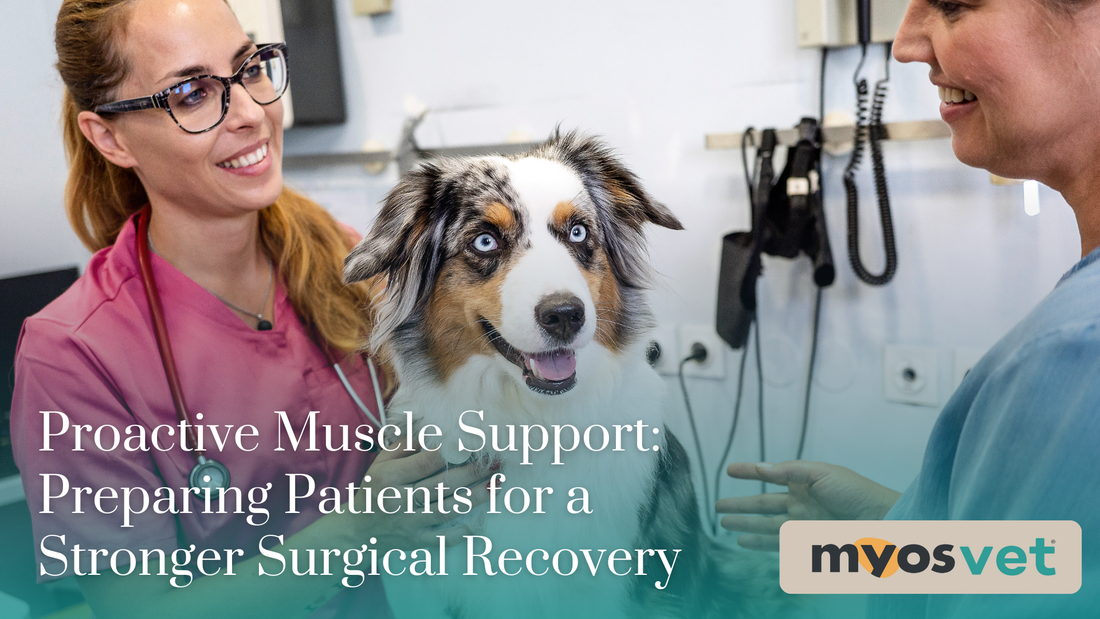
Proactive Muscle Support: Preparing Patients for a Stronger Surgical Recovery
Share
When a pet is scheduled for surgery, the focus often shifts toward the procedure itself and immediate post-operative care. However, what happens before surgery can significantly influence recovery outcomes—especially when it comes to muscle health. Prehabilitation, or “prehab,” is a concept well recognized in human medicine, and can serve as a blueprint for veterinary care.
The Role of Muscle in Surgical Recovery
Muscle tissue plays a critical role in every stage of recovery. Beyond mobility, skeletal muscle supports metabolism, joint stability, and immune function. Pets with greater muscle mass and strength typically demonstrate:
- Faster recovery times
- Improved mobility post-surgery
- Reduced risk of complications such as joint instability and delayed wound healing
- Better tolerance to anesthesia and immobilization
Unfortunately, periods of reduced activity—both leading up to and following surgery—can cause rapid muscle atrophy. Older animals, or those with pre-existing conditions such as osteoarthritis or obesity, are particularly vulnerable.
Why Pre-Surgical Muscle Health Matters
Pre-surgical conditioning provides a protective buffer against muscle loss during the recovery phase. In human orthopedics, studies show that patients who engage in strength-building exercises prior to surgery experience improved functional outcomes post-operatively. The same principles apply to veterinary medicine: stronger muscles going into surgery mean stronger recovery coming out.
For veterinary professionals, incorporating muscle health into pre-surgical protocols can:
- Shorten rehabilitation time
- Enhance overall surgical outcomes
- Support client compliance and satisfaction
- Reduce the likelihood of re-injury or long-term mobility deficits
Strategies for Supporting Muscle Health Before Surgery
1. Nutritional Optimization
Dietary support plays a crucial role in maintaining lean muscle. Ensuring adequate protein intake and amino acid balance helps preserve muscle tissue before and after surgery. Adding Fortetropin®, the active ingredient in MYOS Canine Muscle Formula, offers a clinically validated, all-natural way to support muscle health.
Research has shown that Fortetropin helps reduce muscle atrophy and increase muscle protein synthesis, making it a valuable addition to a pre-surgical regimen—especially for older or mobility-compromised patients.
2. Low-Impact Strength Building
When appropriate, veterinarians can recommend gentle, controlled exercises such as underwater treadmill sessions or resistance walking to improve strength and endurance. Even short daily sessions can help maintain neuromuscular engagement and overall conditioning.
3. Weight Management
Extra weight increases strain on joints and soft tissue during recovery. A focus on achieving or maintaining a healthy body condition score can reduce surgical stress and facilitate easier mobility post-surgery.
4. Client Education
Pet owners often overlook pre-surgical preparation. Encouraging them to think about “building strength before surgery” can help set realistic expectations and improve compliance with both pre- and post-operative care. Simple changes in diet, activity, and supplementation can make a measurable difference.
Setting Patients Up for Success
A patient who enters surgery stronger, leaner, and nutritionally optimized is already ahead in their recovery journey. Proactively addressing muscle health is not just an enhancement to the care plan—it’s a vital component of comprehensive surgical preparation.
By integrating prehabilitation strategies—including targeted nutritional support with Fortetropin—veterinary professionals can help patients recover faster, maintain muscle mass, and regain mobility more effectively.
Key Takeaway
Muscle atrophy doesn’t have to be an inevitable consequence of surgery. Proactive intervention—through proper nutrition, conditioning, and client communication—can make all the difference in post-operative recovery. Start building strength before the first incision, and you’ll be building a better outcome for every patient.
